Benn
(1905-1989)
Born as Bencjon Rabinowicz in what is now the Polish city of Bialystok, the artist known as Benn was a Holocaust survivor whose art, like the works of Marc Chagall and Ben-Zion, came out of the rich culture of East European Judaism, destroyed in World War II. His grandfather was a rabbi, his father was a would-be painter turned architect who designed synagogues, and his mother came from a family of artists and musicians. Bencjon was encouraged from an early age to make art. At 15, he was painting family portraits. Barely out of his teens, the young Rabinowicz organized art classes in the family home, designed sets for the local theater, and had his first solo exhibition.
Rabinowicz was awarded a scholarship in 1929 to study in Paris, where he permanently settled and took on the pseudonym of Benn. A student of Fernand Leger at the Academie Moderne, Benn was linked to the “School of Paris”, a loose grouping of mostly foreign artists in the French capital—many of them, Jewish—representing a variety of avant-garde movements from Cubism to Surrealism. Influenced by modernist trends, Benn remained loyal to figurative art, painting a post-impressionist self-portrait in 1938, reproduced in a postwar monograph by Art Critic Joseph-Marie Lo Duca. In Benn’s illustrations for a 1936 collection of Hebrew poems, we see a simplification of form, characteristic of his later religious art.
When World War II began, Benn submitted works to Parisian shows, while moving with his wife from place to place as refugees. The couple were rounded up with other Jews in 1941 and sent to the Beaune-la-Rolande transit camp in Nazi-occupied France, a way station to the death camps. They were released through the timely intervention of Art Critic Lo Duca and Marcel Brule, a noted professor of medicine, and, ultimately, found a safe haven with the help of French Art Patron Jean Paulhan. During the 26 months Benn was in hiding, he produced over 60 works inspired by his childhood studies of the Hebrew Scriptures, reconfigured multiple times in the post war years.
Benn’s biblical works were the subject of major postwar exhibitions. A landmark 1970 show at the Paris Museum of Modern Art presented 126 of his illustrations of the Psalms. He reproduced 52 of his sacred line drawings in the 1954 album, Visions of the Bible, printed in Tel Aviv. Benn’s magnum opus was a portfolio of 62 psalms and verses from the Bible printed in France in 1960, reproducing line drawings with textual references to accompany heliogravures of paintings, illustrating psalms of praise (and desperation) and familiar narratives of the Hebrew Scriptures like the Sacrifice of Abraham, Jacob’s Ladder, and Elijah in the Fiery Chariot. Variations on the same images appear in a series of color lithographs from the end of the 1960s into the 1970s.
Benn’s biblical art displays a level of abstraction not found in his other figurative studies, an acknowledgement, perhaps, of the traditional prohibition of image-making in Judaism. The inexplicable horrors of the Holocaust brought on a crisis of faith for many Jewish artists, but Benn clung to one often repeated symbol of hope in his work taken from the story in Genesis, where Noah frees a dove from the ark that returns with an olive branch marking the end of Great Flood. He selected the image for the cover of the 1960 portfolio, used the theme in prints and paintings, and adapted the open hands and dove motif for UNESCO posters.
Fluttering wings with Kabbalistic lettering serve as a visible representation of the ineffable in illustrations of passages from the Hebrew Scriptures where God is invoked. They appear hovering over the primordial void in Benn’s image of creation and as the object of human devotion and longing in depictions of Psalm 67:4 and Psalm 143:6. The emblem appears alone with interlocking lines to illustrate the text “from everlasting to everlasting, thou art God (Psalm 90:2).” Originally conceived in the depths of despair, these images touch transcendent mysteries.
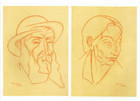
Parents of Bencjon Rabinowicz
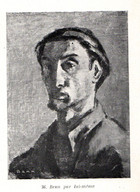
Self Portrait
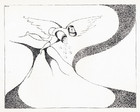
First Poem
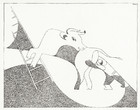
Fourth Poem
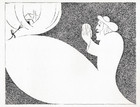
Tenth Poem
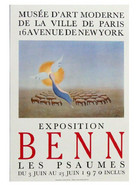
Benn: Les Psaumes
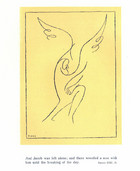
Jacob Wrestling the Angel (Genesis 32:25)
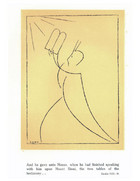
Moses and the Ten Commandments (Exodus 31 :18)
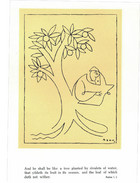
Psalm 1:3

Psalm 98:8,9

Psalm 79:2
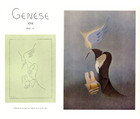
Sacrifice of Abraham (Genesis 22:12)
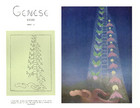
The Ladder of Jacob (Genesis 28:12)

Elijah in the Fiery Chariot (2 Kings 2:11)
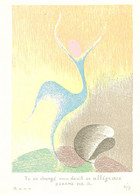
Psalm 30:12
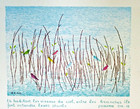
Psalm 104:12
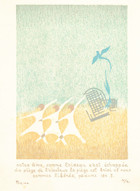
Psalm 124:7
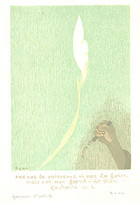
Zechariah 4:6
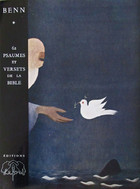
62 Psaumes et versets de la Bible (cover)

Noah and the Dove (Genesis 8:11)
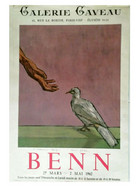
Benn Exhibition

Creation (Genesis 1:2)
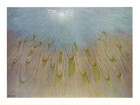
Psalm 67:4
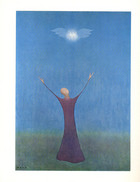
Psalm 143:6

